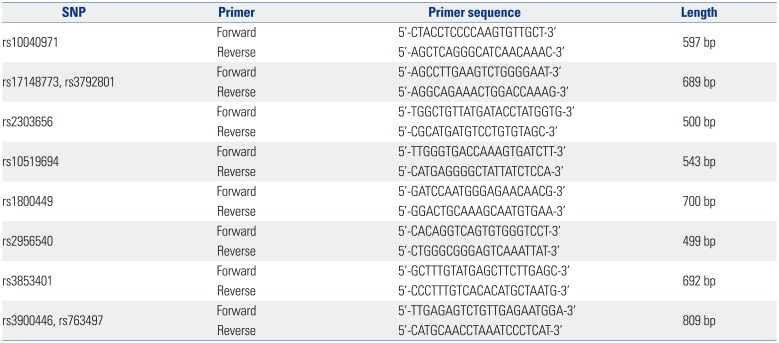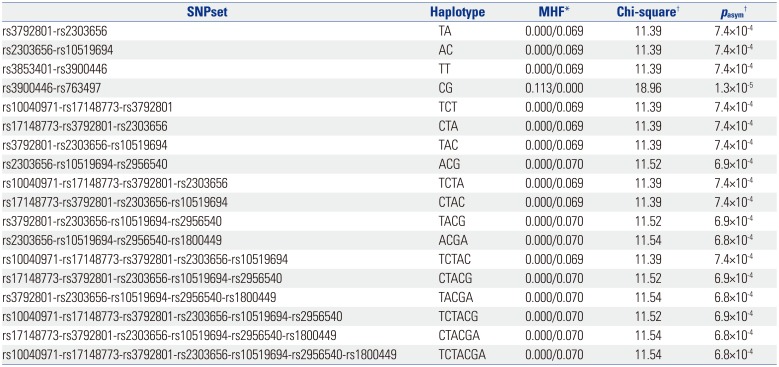1. Schievink WI, Wijdicks EF, Parisi JE, Piepgras DG, Whisnant JP. Sudden death from aneurysmal subarachnoid hemorrhage. Neurology. 1995; 45:871–874. PMID:
7746399.

2. Ruigrok YM, Rinkel GJ, Wijmenga C. Genetics of intracranial aneurysms. Lancet Neurol. 2005; 4:179–189. PMID:
15721828.

3. Myllyharju J, Kivirikko KI. Collagens and collagen-related diseases. Ann Med. 2001; 33:7–21. PMID:
11310942.

4. Hofer A, Ozkan S, Hermans M, Kubassek N, Sitzer M, Burtscher J, et al. Mutations in the lysyl oxidase gene not associated with intracranial aneurysm in central European families. Cerebrovasc Dis. 2004; 18:189–193. PMID:
15273433.

5. Mäki JM, Räsänen J, Tikkanen H, Sormunen R, Mäkikallio K, Kivirikko KI, et al. Inactivation of the lysyl oxidase gene Lox leads to aortic aneurysms, cardiovascular dysfunction, and perinatal death in mice. Circulation. 2002; 106:2503–2509. PMID:
12417550.
6. Onda H, Kasuya H, Yoneyama T, Takakura K, Hori T, Takeda J, et al. Genomewide-linkage and haplotype-association studies map intracranial aneurysm to chromosome 7q11. Am J Hum Genet. 2001; 69:804–819. PMID:
11536080.

7. Sathyan S, Koshy L, Sarada Lekshmi KR, Easwer HV, Premkumar S, Alapatt JP, et al. Lack of association of lysyl oxidase (LOX) gene polymorphisms with intracranial aneurysm in a south Indian population. Mol Biol Rep. 2013; 40:5869–5874. PMID:
24065528.

8. Ma L, Song H, Zhang M, Zhang D. Lysyl oxidase G473A polymorphism is associated with increased risk of coronary artery diseases. DNA Cell Biol. 2011; 30:1033–1037. PMID:
21612403.

9. Zhang HF, Zhao KJ, Xu Y, Hong B, Zhao WY, Liu JM, et al. Lysyl oxidase polymorphisms and ischemic stroke--a case control study. Mol Biol Rep. 2012; 39:9391–9397. PMID:
22722997.

10. Lee VS, Halabi CM, Hoffman EP, Carmichael N, Leshchiner I, Lian CG, et al. Loss of function mutation in LOX causes thoracic aortic aneurysm and dissection in humans. Proc Natl Acad Sci U S A. 2016; 113:8759–8764. PMID:
27432961.

11. Jeong W, Rhee K. Hemodynamics of cerebral aneurysms: computational analyses of aneurysm progress and treatment. Comput Math Methods Med. 2012; 2012:782801. PMID:
22454695.

12. Hoi Y, Meng H, Woodward SH, Bendok BR, Hanel RA, Guterman LR, et al. Effects of arterial geometry on aneurysm growth: three-dimensional computational fluid dynamics study. J Neurosurg. 2004; 101:676–681. PMID:
15481725.

13. Jeon JP, Cho YD, Rhim JK, Yoo DH, Kang HS, Kim JE, et al. Extended monitoring of coiled aneurysms completely occluded at 6-month follow-up: late recanalization rate and related risk factors. Eur Radiol. 2016; 26:3319–3326. PMID:
26747259.

14. Cho YD, Jeon JP, Rhim JK, Park JJ, Yoo RE, Kang HS, et al. Progressive thrombosis of small saccular aneurysms filled with contrast immediately after coil embolization: analysis of related factors and long-term follow-up. Neuroradiology. 2015; 57:615–623. PMID:
25808124.

15. Barrett JC, Fry B, Maller J, Daly MJ. Haploview: analysis and visualization of LD and haplotype maps. Bioinformatics. 2005; 21:263–265. PMID:
15297300.

16. Purcell S, Neale B, Todd-Brown K, Thomas L, Ferreira MA, Bender D, et al. PLINK: a tool set for whole-genome association and population-based linkage analyses. Am J Hum Genet. 2007; 81:559–575. PMID:
17701901.

17. Jeon JS, Ahn JH, Huh W, Son YJ, Bang JS, Kang HS, et al. A retrospective analysis on the natural history of incidental small paraclinoid unruptured aneurysm. J Neurol Neurosurg Psychiatry. 2014; 85:289–294. PMID:
23781005.

18. Schievink WI, Schaid DJ, Michels VV, Piepgras DG. Familial aneurysmal subarachnoid hemorrhage: a community-based study. J Neurosurg. 1995; 83:426–429. PMID:
7666217.

19. Ruigrok YM, Rinkel GJ, Algra A, Raaymakers TW, Van Gijn J. Characteristics of intracranial aneurysms in patients with familial subarachnoid hemorrhage. Neurology. 2004; 62:891–894. PMID:
15037688.

20. Ruigrok YM, Rinkel GJ. Genetics of intracranial aneurysms. Stroke. 2008; 39:1049–1055. PMID:
18258833.

21. Alg VS, Sofat R, Houlden H, Werring DJ. Genetic risk factors for intracranial aneurysms: a meta-analysis in more than 116,000 individuals. Neurology. 2013; 80:2154–2165. PMID:
23733552.

22. Ruigrok YM, Rinkel GJ, Wijmenga C. The versican gene and the risk of intracranial aneurysms. Stroke. 2006; 37:2372–2374. PMID:
16917090.

23. Sathyan S, Koshy LV, Balan S, Easwer HV, Premkumar S, Nair S, et al. Association of Versican (VCAN) gene polymorphisms rs251124 and rs2287926 (G428D), with intracranial aneurysm. Meta Gene. 2014; 2:651–660. PMID:
25606449.

24. Yoneyama T, Kasuya H, Onda H, Akagawa H, Jinnai N, Nakajima T, et al. Association of positional and functional candidate genes FGF1, FBN2, and LOX on 5q31 with intracranial aneurysm. J Hum Genet. 2003; 48:309–314. PMID:
12750963.

25. Ruigrok YM, Rinkel GJ, van’t Slot R, Wolfs M, Tang S, Wijmenga C. Evidence in favor of the contribution of genes involved in the maintenance of the extracellular matrix of the arterial wall to the development of intracranial aneurysms. Hum Mol Genet. 2006; 15:3361–3368. PMID:
17038484.

26. Akiyama K, Narita A, Nakaoka H, Cui T, Takahashi T, Yasuno K, et al. Genome-wide association study to identify genetic variants present in Japanese patients harboring intracranial aneurysms. J Hum Genet. 2010; 55:656–661. PMID:
20613766.

27. Bilguvar K, Yasuno K, Niemelä M, Ruigrok YM, von Und Zu Fraunberg M, van Duijn CM, et al. Susceptibility loci for intracranial aneurysm in European and Japanese populations. Nat Genet. 2008; 40:1472–1477. PMID:
18997786.

28. Tian C, Chen Z, Ma X, Yang M, Wang Z, Dong Y, et al. Comparison of genetic variants in cancer-related genes between chinese Hui and Han populations. PLoS One. 2015; 10:e0145170. PMID:
26683024.

29. Inoue K, Asao T, Shimada T. Ethnic-related differences in the frequency distribution of genetic polymorphisms in the CYP1A1 and CYP1B1 genes in Japanese and Caucasian populations. Xenobiotica. 2000; 30:285–295. PMID:
10752643.

30. Joo SP, Lee JK, Kim TS, Kim MK, Lee IK, Seo BR, et al. A polymorphic variant of the endoglin gene is associated with increased risk for intracranial aneurysms in a Korean population. Surg Neurol. 2008; 70:39–44. PMID:
18440621.

31. Bruno G, Todor R, Lewis I, Chyatte D. Vascular extracellular matrix remodeling in cerebral aneurysms. J Neurosurg. 1998; 89:431–440. PMID:
9724118.

32. Hong EP, Park JW. Sample size and statistical power calculation in genetic association studies. Genomics Inform. 2012; 10:117–122. PMID:
23105939.

33. Yasuno K, Bilguvar K, Bijlenga P, Low SK, Krischek B, Auburger G, et al. Genome-wide association study of intracranial aneurysm identifies three new risk loci. Nat Genet. 2010; 42:420–425. PMID:
20364137.









 PDF
PDF ePub
ePub Citation
Citation Print
Print


 XML Download
XML Download